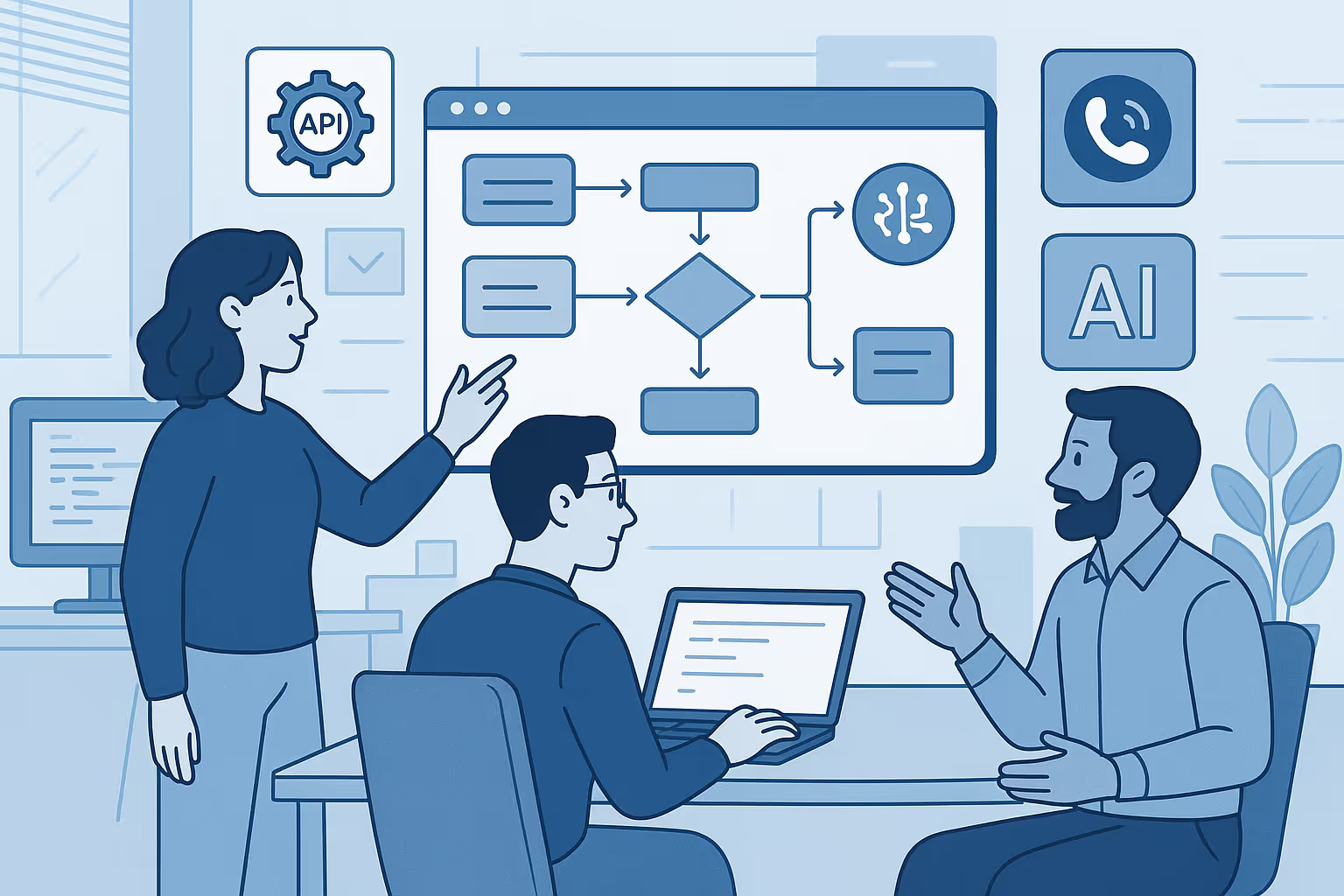Why AI Contact Centers Are Essential in 2025
The role of artificial intelligence in contact centers has grown exponentially. A recent study shows that 57% of customer care leaders expect an increase in call volumes over the next one to two years. In response, businesses are adopting AI-powered contact centers to handle this scale efficiently while preserving service quality. These solutions not only reduce agent labor costs - projected to save $80 billion globally by 2026 - but also ensure faster response times and seamless support across channels.
Benefits of AI in Contact Centers
AI contact center software delivers tangible, multi-dimensional benefits:
- Improved customer satisfaction: Real-time responses, intelligent routing, and personalized service improve every interaction.
- Agent productivity: Automation of low-value tasks enables agents to focus on complex issues, boosting efficiency.
- Actionable insights: AI analyzes every customer interaction, offering sentiment detection, performance metrics, and service quality trends.
- Operational cost reduction: AI systems reduce average handling time, improve first-call resolution, and optimize staffing levels.
- Enhanced customer loyalty: Faster, smarter resolutions reduce churn and increase customer lifetime value.
AI Contact Center Capabilities to Watch
Modern AI-powered contact center technology integrates several advanced components:
- Natural Language Processing (NLP): Understands customer intent to facilitate faster resolutions and route inquiries accurately.
- Machine Learning: Continuously improves predictions and recommendations based on historical and real-time data.
- Predictive Analytics: Forecasts call volumes and identifies high-risk customer scenarios to enable proactive outreach.
- Virtual Agents & Chatbots: Deliver scalable self-service, manage FAQs, and reduce human agent workload.
- Real-Time Agent Assist Tools: Provide agents with contextual prompts, compliance reminders, and resolution suggestions during live conversations.
- Automated Quality Management: Evaluates 100% of customer interactions for consistency, compliance, and performance.
The Rise of Voice AI in Contact Centers
One of the fastest-growing subcategories within contact center AI is voice AI - the ability to process, analyze, and act on real-time spoken conversations. Voice AI platforms now enable:
- Live call transcription for accurate records and real-time coaching
- Intent detection and topic extraction from natural speech
- Context-aware guidance that prompts agents with relevant data mid-conversation
- Automated summaries that populate CRMs or ticketing systems
These capabilities empower agents to stay focused on the customer while reducing after-call work and improving documentation quality.
Fluents.ai, a leading voice AI platform, exemplifies this new wave of innovation. Their technology transforms live conversations into structured, actionable data - guiding agents in real time and boosting contact center productivity without sacrificing personalization.
Implementing Contact Center AI: Strategic Guide
Deploying AI in contact centers requires a phased, well-integrated approach:
- Map the customer journey: Identify high-friction touchpoints where AI can add immediate value.
- Integrate with existing systems: Ensure compatibility with legacy infrastructure to streamline adoption.
- Train agents effectively: Equip teams with the skills to leverage AI-driven agent assist tools for optimal performance.
- Monitor, measure, and optimize: Continuously evaluate AI outputs against KPIs like first-contact resolution, CSAT, and handling time.
- Ensure data compliance: Align AI systems with regulatory frameworks such as GDPR and HIPAA.
Key Trends in Contact Center AI Technology
AI contact centers in 2025 are at the forefront of several transformative trends:
- Generative AI & conversational AI: Deliver human-like dialogue and deeper personalization across all customer channels.
- Sentiment-aware systems: Use AI to detect tone and emotion, enabling better escalation handling and customer retention.
- Cloud-native architecture: Facilitates rapid deployment, scalability, and seamless integration with AI APIs.
- Multimodal support: Combines voice, chat, email, and SMS into cohesive omnichannel workflows.
- Feedback-driven optimization: Uses AI to analyze customer feedback loops and refine service delivery in real time.
Best Practices for Contact Center AI Success
To maximize ROI from contact center AI investments:
- Start with controlled pilots: Validate success with measurable outcomes before scaling.
- Maintain human-AI balance: Position AI to augment, not replace, skilled human agents.
- Prioritize agent enablement: Real-time guidance tools enhance both speed and empathy in interactions.
- Use structured content & schema: Ensure AI-readability with FAQ blocks, comparison tables, and How-To schemas.
- Align with core metrics: Optimize AI usage around NPS, resolution time, customer effort score, and retention.
Conclusion: The Future of the Artificial Intelligence Contact Center
The artificial intelligence contact center represents a paradigm shift in how businesses engage, support, and retain customers. From automating repetitive tasks and enhancing agent performance to delivering predictive service and emotional intelligence at scale, AI contact center technology is becoming indispensable. Companies that successfully implement contact center AI solutions will outperform on customer satisfaction, agent efficiency, and profitability.
As generative AI, voice AI, and real-time agent assist tools become the new standard, the contact centers of 2025 will serve not just as support hubs-but as revenue drivers and strategic assets. Organizations that invest now in intelligent, scalable, and human-aligned AI capabilities will be best positioned to meet evolving customer expectations and lead in an AI-first service economy.
From 10 calls a day to 85,000, Fluents scales with you. Automate globally, integrate deeply, and never worry about your call infrastructure again.

Stay Connected
Check out our latest updates, customer stories, and resources to keep leveling up with Fluents.
FAQs on AI Contact Centers in 2025
Explore the ways AI-driven sentiment analysis enhances customer interactions, boosts satisfaction, and optimizes service delivery.
Implementing AI in contact centers by 2025 offers transformative benefits that enhance both customer experience and operational efficiency. AI-driven solutions enable real-time responses, intelligent routing, and personalized service, significantly improving customer satisfaction. By automating low-value tasks, AI allows agents to focus on complex issues, boosting productivity and efficiency. Additionally, AI provides actionable insights through sentiment detection and performance metrics, helping businesses optimize service quality and reduce operational costs.
- Improved customer satisfaction: AI ensures faster response times and seamless support across channels.
- Agent productivity: Automation of routine tasks allows agents to concentrate on more complex customer needs.
- Operational cost reduction: AI optimizes staffing levels and reduces average handling time.
By adopting AI-powered contact centers, businesses can not only save on labor costs but also enhance customer loyalty through faster, smarter resolutions. As AI technology continues to evolve, companies that invest in these capabilities will be well-positioned to meet the growing demands of customer service, ultimately driving profitability and competitive advantage in an AI-first service economy.
AI enhances customer loyalty and reduces churn in contact centers by providing faster, more personalized service, which leads to improved customer satisfaction and retention. By leveraging AI technologies such as Natural Language Processing and Machine Learning, contact centers can understand customer intent, predict needs, and offer tailored solutions in real-time.
- AI-driven insights help identify at-risk customers, enabling proactive engagement to address issues before they lead to churn.
- Automated systems streamline interactions, reducing wait times and ensuring consistent service quality across channels.
- AI-powered analytics provide actionable data on customer behavior and preferences, allowing for more targeted loyalty programs.
By integrating AI, contact centers not only enhance customer experiences but also drive operational efficiencies, ultimately increasing customer lifetime value and positioning businesses to thrive in an AI-first service economy.
By 2025, businesses should focus on essential AI-powered contact center capabilities that enhance customer experience and operational efficiency. AI contact centers are crucial for managing increased call volumes while maintaining service quality. They offer significant cost savings, faster response times, and seamless support across multiple channels.
- Natural Language Processing (NLP): Enables understanding of customer intent for accurate inquiry routing and faster resolutions.
- Machine Learning: Continuously refines predictions and recommendations using historical and real-time data.
- Predictive Analytics: Anticipates call volumes and identifies high-risk scenarios for proactive customer engagement.
- Virtual Agents & Chatbots: Provide scalable self-service options, reducing the workload on human agents.
Investing in these AI capabilities will not only improve customer satisfaction and loyalty but also drive operational efficiency and profitability. As AI technology evolves, contact centers will transform into strategic assets that enhance customer engagement and generate revenue.




